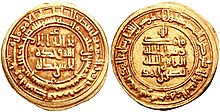Samanids
The Samanids ( Persian سامانیان, DMG Sāmāniyān ) were a Persian-born , Muslim dynasty with considerable political and cultural influence. Of its capital Bukhara from their prevailed emirs 819-1005 over wide areas in Transoxania and Khorasan , but were under the Caliphate of the Abbasids in Baghdad .
Rise and peak of power
The progenitor of the dynasty, Saman Chuda, came from an old Iranian family from Balkh and was, according to the dynasty itself, a descendant of Bahram Chobin , a general of the Sassanids . The first Samanids became governors of the Tahirids in Samarkand , Ferghana , Shasch and Herat in 819 .
Nasr I. ibn Ahmad (874-892) was appointed governor in Transoxania by the Abbasids in 874 after the fall of the Tahirids by the Saffarids and was able to rule effectively independently. Bukhara became the capital of the dynasty. Under Ismail I (892–907), the Saffarids were driven out of Khorasan and control over large parts of eastern Iran was gained. Ismail also pushed the Oghuz people back, triggering the chain reaction in the steppe that led to the appearance of the Magyars (i.e. the Hungarians) in Pannonia (around 895). With Nasr II (914-943) the empire reached its greatest expansion in Central Asia and Iran, with the border areas to India being reached. In the 10th century, the Banijurids of Chuttal with the capital Hulbuk and other small empires in Central Asia were under the rule of the Samanids. When Nasr's reign came to an end, there were unrest, among other things because the army received no pay. After 945, the Sunni Samanids were also pushed out of western Persia by the Shiite Buyids .
Trade and economy
In the 10th century Transoxania was the hub of international trade between East and West. In addition to trade relations in the Middle East and the Chinese Empire, there were also connections to India and the Volga region . Countless goods were traded (including soap, fabrics, wool, carpets, furs, make-up, oil, metal vessels, honey, nuts, melons, weapons, slaves, horses). Certain Central Asian melons were so popular that they were transported in lead boxes filled with snow to Baghdad, where they fetched exorbitant prices (seven to ten times as much per fruit as a slave). Hundreds of thousands of Samanid silver coins have been found in Europe, many of them in Sweden, and they were also used in Mainz in the 10th century, according to a slave trader named Ibrahim Jakub ( Ibrahim ibn Yaqub ). In addition to trade relations, the irrigation field economy and a highly developed mining industry also flourished . Due to the economic wealth, the Samanids were able to develop a rich construction activity, especially in the cities. Is received from it z. B. the Samanid mausoleum in Bukhara.

Literature and erudition
Under Mansur I (961–976) and Nuh II (976–997), the capital Bukhara rose to a center of Persian culture through the promotion of the Samanids . Persian-Islamic literature in particular flourished, which contributed to the rise of the New Persian language . It is mainly linked to poets like Rudaki († 941), whose main work Kalīla wa Dimna reworked Indian fables and was illustrated by Chinese painters. Also the Shahnameh called major work Firdausi († 1020) was one more in the Samanidenzeit because Mahmud of Ghazni brought little understanding of it. Even the polymath al-Biruni and the medical practitioner Ibn Sina began their careers under the Samanids. An important cultural and literary point of reference was the history of the Sassanid Empire .
Decline and decline
The Samanids relied on the East Iranian landed gentry. In the course of the 10th century, military slaves were taken over into the army in order to keep the Turkish nomadic tribes in Central Asia under control. The slave soldiers became a power factor at court that soon got the emirs in trouble. In 961, when the emir died, their leaders attempted to overthrow in Bukhara, with the palace being destroyed. Since the middle of the 10th century, some officers in the provinces have also made themselves independent. Especially the General founded ALP TIGIN 962 semi-independent rule of the Ghaznavids , the 994 as a result of another military rebellion was in control of all Khorasan. In addition to the conspiracies at court and among the military governors in the provinces, there were also unrest among the urban population, peasant uprisings and sectarian disputes.
At the end of the 10th century, the Samanids were no longer able to cope with the simultaneous pressure of the Ghaznavids in the south and the Qarakhanids from the east. The clergy and the townspeople were passive when Bukhara was occupied by the Qarakhanid Arslan-Ilek Nasr in October 999 and the ruling family with Abd al-Malik II at their head was captured. The pretender to the throne Ismail II (Ismāʿīl ibn Nūḥ al-Muntaṣir) escaped, but his fight for the restoration of the Samanid Empire was unsuccessful; the dynasty ended with his murder in 1005.
Today's Tajiks trace their ancestry and culture back to the Samanid dynasty. Ismail I, the most famous Samanid ruler, is now considered the national hero and father of the nation in Tajikistan . The highest mountain in the country, Pik Ismoil Somoni (7495 m) is named after the ruler. The name of the modern currency of Tajikistan, Somoni , is also derived from the name of the dynasty.
architecture
The conquest by the Arabs hardly brought any new forms of architecture to Central Asia; rather, the architecture of the Abbasids was influenced by Central Asian models. For example, palaces and tombs in Choresm were the model for corresponding buildings in Baghdad and Samarra in the 8th and 9th centuries, with both the floor plan (domed room with four halls and courtyards) and the stucco design being used as models.
Of the mausoleums , the Samanid mausoleum in Bukhara is preserved, as is the Arab-Ata in Tirmidh . The Arab-Ata was built according to the inscription 977/8 and, unlike the Samanid mausoleum in Bukhara, has a magnificent facade.
Rough remains of a palace from the 10th century have been preserved in Tirmidh: The Kyrk-Kyz was a two-story complex with a side length of about 54 meters and a central space of 11 meters. The appearance has been referred to as the "central dome kiosk".
Three aristocratic palaces from the Samanid period have been found in Old Samarkand (Afrasiyab). One of them consisted of three rooms with a central dome and a columned hall in front and contained extensive stucco work. A second was also a domed structure and the third presented a hall with stucco, namely geometrically connected floral ornaments (discovered in 1919). Incidentally, Old Samarkand was already fortified and had ten city gates.
Family tree and list of rulers
- Ahmad (I.) b. Asad b. Saman Chuda (r. 819-874)
- Nasr (I.) b. Ahmad (ruled 874-892)
- al-Amir al-Mahdi Abu Ibrahim Ismail b. Ahmad, short Ismāʿīl ibn Aḥmad (r. 892-907)
- al-Amir al-Shahid Abu Nasr Ahmad (II.) b. Ismail, Aḥmad ibn Ismāʿīl for short (r. 907-914)
- al-Amir as-Said Nasr (II.) b. Ahmad, or Naṣr ibn Aḥmad for short (r. 914–943)
- al-Amir al-Hamid Nuh (I.) b. Nasr, or Nūḥ ibn Naṣr for short (r. 943–954)
- al-Amir al-Muayyad (or al-Muwaffaq) Abu l-Fawaris Abd al-Malik (I.) b. Nuh, in short Abd al-Malik ibn Nūḥ I. (r. 954–961)
- al-Malik al-Muzaffar al-Amir al-Sadid Abu Salih Mansur (I.) b. Nuh, short Manṣūr ibn Nūḥ I. (r. 961–976)
- al-Amir ar-Radi (or ar-Raschid) Abu l-Qasim Nuh (II.) b. Mansur, or Nūḥ ibn Manṣūr for short (r. 976–997)
- Abu l-Harith Mansur (II.) B. Nuh, short Manṣūr ibn Nūḥ II. (R. 997–999)
- Abu l-Fawaris Abd al-Malik (II.) B. Nuh , in short ʿAbd al-Malik ibn Nūḥ II. (Ruled 999–1000)
- Abu Ibrahim Ismail (II.) Al-Muntasir b. Nuh, short Ismāʿīl ibn Nūḥ (ruled 1000-1005)
literature
- Richard N. Frye : The Samanids. In: The Cambridge History of Iran. Volume 4: Richard N. Frye (Ed.): The period from the Arab invasion to the Saljuqs. Cambridge University Press, Cambridge u. a. 1975, ISBN 0-521-20093-8 , p. 136 ff.
- Tilman Nagel : The Islamic world until 1500 ( Oldenbourg floor plan of history. Vol. 24). Oldenbourg Wissenschaftsverlag, Munich 1998, ISBN 3-486-53011-9 , p. 95 ff.
- Monika Gronke : History of Iran. From Islamization to the present (= Beck series. C.-H.-Beck-Wissen 2321). 2nd, revised and updated edition. Beck, Munich 2006, ISBN 3-406-48021-7 .




